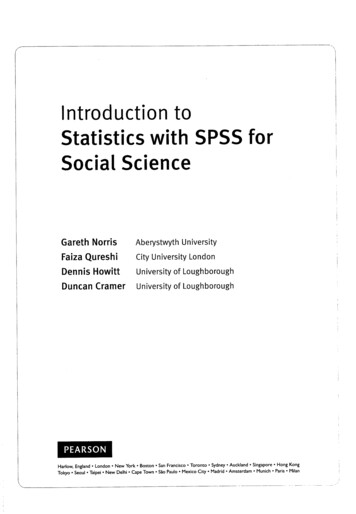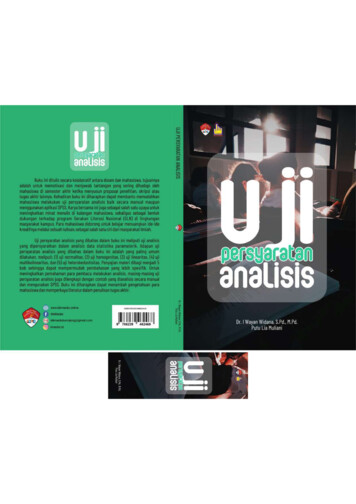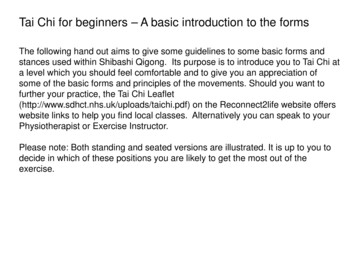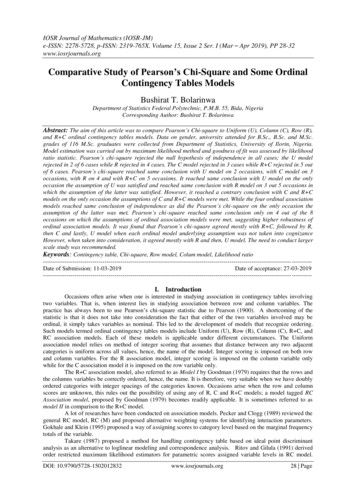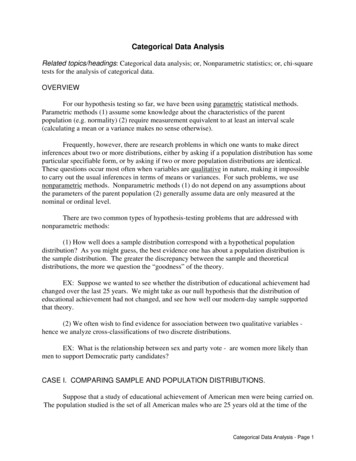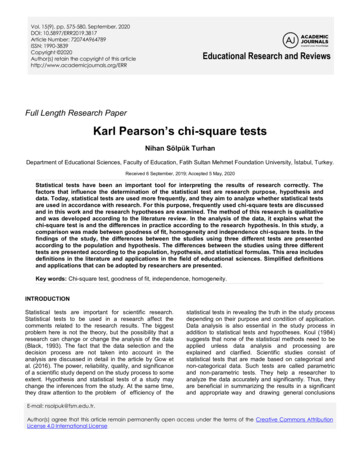
Transcription
Vol. 15(9), pp. 575-580, September, 2020DOI: 10.5897/ERR2019.3817Article Number: 72074A964789ISSN: 1990-3839Copyright 2020Author(s) retain the copyright of this nal Research and ReviewsFull Length Research PaperKarl Pearson’s chi-square testsNihan Sölpük TurhanDepartment of Educational Sciences, Faculty of Education, Fatih Sultan Mehmet Foundation University, İstabul, Turkey.Received 6 September, 2019; Accepted 5 May, 2020Statistical tests have been an important tool for interpreting the results of research correctly. Thefactors that influence the determination of the statistical test are research purpose, hypothesis anddata. Today, statistical tests are used more frequently, and they aim to analyze whether statistical testsare used in accordance with research. For this purpose, frequently used chi-square tests are discussedand in this work and the research hypotheses are examined. The method of this research is qualitativeand was developed according to the literature review. In the analysis of the data, it explains what thechi-square test is and the differences in practice according to the research hypothesis. In this study, acomparison was made between goodness of fit, homogeneity and independence chi-square tests. In thefindings of the study, the differences between the studies using three different tests are presentedaccording to the population and hypothesis. The differences between the studies using three differenttests are presented according to the population, hypothesis, and statistical formulas. This area includesdefinitions in the literature and applications in the field of educational sciences. Simplified definitionsand applications that can be adopted by researchers are presented.Key words: Chi-square test, goodness of fit, independence, homogeneity.INTRODUCTIONStatistical tests are important for scientific research.Statistical tests to be used in a research affect thecomments related to the research results. The biggestproblem here is not the theory, but the possibility that aresearch can change or change the analysis of the data(Black, 1993). The fact that the data selection and thedecision process are not taken into account in theanalysis are discussed in detail in the article by Gow etal. (2016). The power, reliability, quality, and significanceof a scientific study depend on the study process to someextent. Hypothesis and statistical tests of a study maychange the inferences from the study. At the same time,they draw attention to the problem of efficiency of thestatistical tests in revealing the truth in the study processdepending on their purpose and condition of application.Data analysis is also essential in the study process inaddition to statistical tests and hypotheses. Koul (1984)suggests that none of the statistical methods need to beapplied unless data analysis and processing areexplained and clarified. Scientific studies consist ofstatistical tests that are made based on categorical andnon-categorical data. Such tests are called parametricand non-parametric tests. They help a researcher toanalyze the data accurately and significantly. Thus, theyare beneficial in summarizing the results in a significantand appropriate way and drawing general conclusionsE-mail: nsolpuk@fsm.edu.tr.Author(s) agree that this article remain permanently open access under the terms of the Creative Commons AttributionLicense 4.0 International License
576Educ. Res. Rev.(Karagöz, 2010).In parametric tests, actions are taken based on aparameter, a specific distribution and the concept ofvariance in the statistics. They are inflexible statisticalmethods related to population or sample. A parametricstatistical test makes an assumption on the populationparameters and the distributions where the data areobtained. Accordingly, some assumptions such assuitability of the data to normal distribution, their randomselection and quantitative form are based on. Such testscontain Student-t tests and ANOVA test assuming thatthe data come from a normal distribution.Non-parametric tests are dealt without being based onpopulation distribution or population parameters. Whenthe word “non-parametric” is used in statistics, it does notmean that nothing is known about the population. Thisgenerally means that we know that the population datado not have a normal distribution. A generalization cannotbe made based on the results obtained from thehypotheses used in such tests (Gay, 1976). According toOnyango and Odebero (2009) as the population is notknown to be normal, sample size is small and thevariables expressed as nominal or ordinal.Non-parametric tests include many tests such as Chisquare, Mann-Whitney U, Sign, Wilcoxon, Median,Kolmogorov-Smirnov and McNemar. Chi-square test isused in discrete data in the form of frequency. It is anindependence test and is used to estimate the probabilityof some non-random factors to take account of theobserved correlation. When the literature is examined,similar studies related to the distribution of p-value insmall sample size were found in the majority of thestudies (Mehotra et al., 2003). Chi-square test shall betaken into consideration in this study. The reason is thatthis test is commonly used by researchers compared toother non-parametric tests. This study deals withapplications of Chi-square test and its use in educationalsciences.Karl Pearson (1857-1936) (Magnello, 2005). Chi-squaregoodness of fit tests, independence tests, andhomogeneity tests that were developed by Pearson arethe most significant contributions that he made to themodern statistics theory. The significance of Chi-squaredistribution of Pearson is that statisticians can usestatistical methods that do not depend on normaldistribution in order to interpret findings. The significanceof Chi-square value is determined by using the suitabledegree of freedom and degree of significance andconsulting a Chi-square table (Moore, 1994). The twospecial purposes of Chi-square test are to test thehypothesis that there is no correlation among two or moregroups, populations or criteria, and to test to what extentthe observed data distribution fits to the expecteddistribution.Chi-square testData collectionChi-square test is used to find if there is any correlationamong nonnumeric variables that are frequently used in2statistical studies (Kothari, 2007). It is symbolized as χ .Kothari (2007) stated that the following requirementsmust be fulfilled before the test.(i) Observed and expected observations are to becollected randomly.(ii) All the members (or items) in the sample must beindependent.(iii) None of the groups must contain very few items (lessthan 10).(iv) The number of total items must be quite large (atleast 50).The logic of hypothesis testing was first developed byPurpose of the studyThe purpose of this work is to compare chi-square tests,goodness of fit tests, independence tests andhomogeneity tests of Karl Pearson. The differenceamong these three types of test and each type needs tobe examined. Different article samples that werepublished by using three different test methods arepresented. The purpose of this article is to provide aquick general overview of chi-square test.METHODOLOGYThis study contains collection of current literature, its criticalanalysis and the data from various sources. Literature analysis thatis a qualitative research data collection method is used in thisstudy, and the aim is to do an in-depth analysis of the studyproblem. Findings obtained by including recent studies on aparticular subject in literature reviews are presented under variousconcepts or themes (Grant and Booth, 2009).Literature review is generally used as a combination of themethodologies in the same study case. Literature review is usedand the articles and scientific sources related to the study subjectare utilized in this study. In this research, Google scholar andScienceDirect databases were used in literature review. First of all,the definitions regarding the three different managements and thedifferences in the steps in the analysis process were revealed bythe findings obtained from the literature review. Later, researchesdeveloped using chi-square goodness of fit, independence andhomogeneity tests were handled according to the purpose,hypothesis and result.Data analysisThe literature that can be used for systematic evaluation isanalyzed by collecting them in different ways in the study. Dataanalysis is examined and reported as part of the previous literatureresearches. By this means, the data in the literature are compared,
Turhan577Table 1. Chi-square tests and attributes.Chi-square testattributeTest of independenceSampling typeSingle dependent sampleInterpretationAssociation between variablesNull hypothesisNo association betweenVariablesTest of homogeneityTwo (or more)independent samplesDifference in proportionsNo difference inproportion betweengroupsTest of goodness of fitSample from populationDifference from populationNo difference in distributionbetween sample andpopulationSource: Franke et al. (2012).examined and synthesized. The factors to be taken intoconsideration in effective and efficient analysis of the study resultsby using Karl Pearson Chi-square tests are presented in the study.Definitions of various authors on these tests are examined.Attributes and application areas of chi-square goodness of fit,independence, and homogeneity tests and the conceptual modelare also stated. Finally, different studies that were made by usingthese tests are dealt with.FINDINGSIn this study, the differences by the purpose andcondition of application of chi-square test and the sampleanalyses are obtained from the studies in the literature.Chi-square test is examined under three titles dependingon its purpose and condition of application:(1) Chi-square goodness of fit test(2) Chi-square independence test(3) Chi-square homogeneity testIn Table 1, three different chi-square tests werecompared. These tests were examined according tosampling type, interpretation and null hypothesis. In thisregard, these distinctions can best be explained by thenull hypothesis and sampling type tested in each of thesetests. So, interpretation can change depending on these.Chi-square of goodness of fit testChi-square of goodness of fit test is also called singlesample goodness of fit test or Pearson’s Chi-square ofgoodness of fit test. This test is a single-sample nonparametric test.(i) Cases (for instance, participants) are obtained from asingle categorical variable. For example, “educationalbackground” consisting of two groups: “high school” and“university”.(ii) Distribution is obtained from a known or hypothesizeddistribution. For example, a known distribution such asthe rate of literate and illiterate persons in a country or ahypothesized distribution such as the rate of mencompared to women in the number of participants of theuniversity admission exam in the next year.While chi-square of goodness of fit test is applied, it isimportant to “hypothesize” if we can expect the cases ineach group of the categorical variable to be “equal” or“unequal”. Mutai (2000) suggests that goodness of fit testis far from comparing the data that are empirically derivedto the results that are expected theoretically (expected tobe frequencies).In data analysis, it is required to find degrees offreedom, expected frequency counts, test statistics and Pvalue related to the test statistic. Degrees of freedom(DF) are equal to (k) number of minus 1 levels of thecategorical variable.DF k – 1Expected frequency count is equal to the expectedfrequency counts at each level of the categoricalvariables, and the sample size of the rate is hypothesizedby using the null hypothesis.Ei npiEi, is the expected frequency for ith level of thecategorical variable, n is the total sample size, and pi, isthe hypothesized rate of the observations at i level. Thevalue of Chi-Square goodness of fit test is calculated byusing the formula,(Oi Ei )2X Ei2Oi, is the observed frequency count for ith level of thecategorical variable, and Ei, is the expected frequencycount for ith level of the categorical variable.Hypothesis of Chi-square of goodness of fit test is statedthus,H0: Data follow a specified distribution.
578Educ. Res. Rev.Table 2. Sample analysis related to chi-square of goodness of fit test.Aim“The constant error of thehalo in educational outcomesresearch” (Pike, 1999)H0 hypothesis“Traditional and halo models includingboth college experience and gain factorswere specified and tested” (Pike, 1999)Result“The chi-square goodness-of-fit statistic for thetraditional model was statistically significant2(x 1180.25; df 360; p 0.001)” (Pike, 1999)Table 3. Sample analysis related to Ci-square test of independency.AimH0 hypothesis“In this study, the correlation betweenthe proportional reasoning skill andthe ratio and proportion problemposing skill of primary school studentsis studied” (Çelik and Özdemir, portional reasoning levelsand problem posing skills ofthe students” (Çelik andÖzdemir, 2011).H1: Data do not follow the specified distribution.The comment on rejection is that the sample issignificantly different from the population by thecorrelation variable. Table 2 contains a sample study inwhich a sample related to chi-square of goodness of fittest is compared to a population that has knownparameters in a correlation variable.Chi-square test of independenceIt evaluates if some categorical variables are correlatedwith some populations, because variables tend to be a bitdifferent from their populations. However, it is notprobable for the variables in a sample to have a strongcorrelation if the variables are independent in the wholepopulation. Consequently, we conclude that the variablesare probably not independent in the population.In data analysis, it is required to find degrees offreedom, expected frequencies, test statistics and Pvalue related to the test statistic.Degree of freedom (DF) is equal to the following:DF (r - 1) * (c - 1)In this formula, r is a variable and c is the level numberfor the other categorical variable.Expected frequency counts are calculated separately foreach level of a categorical variable at each level of theother categorical variable. According to the formulabelow, r * c gives the expected frequencies.Er, c (n r * n c) / nEr, c is the expected frequency number for level r of thevariable A and level c of the variable B.n r is the total sample observation number at the level r ofthe variable A.Result“Pearson chi-square value is found 185.63.According to the values p, the value p 0.05 isobtained, so it is found that there is a significantcorrelation between proportional reasoning levels andproblem posing skills of the students” (Çelik andÖzdemir, 2011).n c is the total sample observation number at the level c ofthe variable Bn is the total sample size.Test statistic. Test statistic is a chi-square random2variable that is defined by the equation below (Χ ).22Χ Σ [(O r, c - E r, c) / E r, c]Or, cis the observed frequency number at the level r of thevariable A and the level c at the variable B.Er,c is theexpected frequency number at the level r of the variableA and the level c of the variable B.The value P is the observation probability of a samplestatistic that is as extreme as test statistic. Test statistic ischi-square, so it is used to evaluate a probability that isrelated to the test statistics. The degrees of freedom thatare calculated above are used in it.Hypothesis of Chi-square test of independence is statedbelow.H0: Correlation variables are independent.H1: Significant variables are correlated.In Table 3, the hypothesis sentence and the test resultrelated to chi-square test of independence are given. Chisquare test of independence determines if the twocategorical variables in a single sample are independentfrom each other.Chi-square test of homogeneityThe test is applied to a single categorical variable fromtwo or more different populations. It is used to determineif frequency counts are distributed among different
Turhan579Table 4. Sample analysis related to chi-square homogeneity test.AimH0 hypothesis“This relative distribution can be used to test forhomogeneity between groups, and the groups havingrelatively higher distribution are favored by the studentsto make their decision” (Paul and Smith-Hunter, 2011).“Drinkers and nondrinkersare not homogeneous”(Paul and Smith-Hunter,2011).populations in the same way. The only differencebetween the independence test and homogeneity test isthe specification of null hypothesis. The homogeneity testtests the null hypothesis that claims homogeneity orequality based on some attributes.Chi-square test of homogeneity is used to determine iftwo or more independent sample vary by distributions ona single variable. A common use of this test is tocompare two or more groups or conditions on acategorical result. Formulation of omnibus test statistic isformed as independence test and homogeneity test. But,although they are the same, there are differences inthese two test sampling hypotheses. Hypothesis of Chisquare homogeneity test is stated below.H0: Distribution of correlation variables is the same.H1: Distribution of the significant variables is not thesame.In Table 4, chi-square independence test was made inthe study, and whether the groups vary by distribution ofthe significant variable as a result was analyzed.DISCUSSIONThis study emphasizes the definition and differentapplications of Chi-square test. Applications of chi-squarehomogeneity, goodness of fit and independence tests areexamined in detail. A simplified conceptual model thatcan be applied in most cases was developed in order tounderstand different chi-square tests. Althoughformulations of the omnibus test statistic of chi-squareindependence and chi-square homogeneity test that areused in many scientific studies are the same, these twotests vary in sampling hypotheses, null hypotheses andthe subsequent rejecting options. The main differencebetween these two tests is the manner of collection andsampling of data. Formulation of chi-square goodness offit test statistic and its hypothesis are different fromothers.Specifically, independence test collects data on asingle sample and then compares the two variables inthis sample in order to determine the correlation betweenthem. When the data are collected by using only a singlesample in chi-square independence test, onlyindependence test is valid. In this test, comments canResult“Chi-square test of homogeneity showsthat these two groups (drinkers andnondrinkers) are not homogeneous interms of citations” (Paul and SmithHunter, 2011).be made only on the correlation between the variables.In homogeneity test, the data from two or more differentgroups are collected. The two samples are thencompared on a single significant variable in order to test ifthere is any difference between the rates. When the datafrom two or more samples are collected in chi-squarehomogeneity test, the homogeneity test is suitable andcomparison of rates can be made among multiple groups.Wickens (1989) presents a delicate and concisedescription of these tests as well as their samplingassumptions and hypotheses. In addition to homogeneityand independence tests, Wickens presents an additionalalternative in which both margins are constant „irrelevantclassification test‟.In general, chi-square test is a strong statistics thatenables the testing of the hypotheses related to thevariables that are measured at nominal level. However,important factors to be considered while using chi-squaretest should be suitable for the purpose, hypothesis anddata of the test. This method is frequently used especiallyin small sample quantitative research. In this line, the aimand hypothesis of the research should be clearly statedand it is important to make an appropriate analysis.CONFLICT OF INTERESTSThe author has not declared any conflict of interests.REFERENCESBlack F (1993). Beta and return. Journal of Portfolio Management 20:818.Çelik A, Özdemir EY (2011). The relationship between the proportionalreasoning skills of primary school students and their ability to form aratio-proportion problem. Pamukkale Üniversitesi Eğitim FakültesiDergisi 30(1):1-11.Franke TM, Ho T, Christie CA (2012). The chi-square test: Often usedand more often misinterpreted. American Journal of Evaluation33(3):448-458.Gay LR (1976). Educational research: Competencies for analysis andapplication. Ohio, Bell & Howell Company.Gow ID, David FL, Peter CR (2016). Causal inference in accountingresearch. Journal ofAccounting Research 54:477-523.Grant MJ, Booth A (2009). A typology of reviews: An analysis of 14review types and associated methodologies. Health Information andLibraries Journal, 26(2):91-108.Karagöz Y (2010). Nonparametrik tekniklerin güç ve etkinlikleri.Elektronik Sosyal Bilimler Dergisi 33:1-23.Kothari CR (2007). Quantitative techniques. New Delhi, UBS PublishersLtd.
580Educ. Res. Rev.Koul L (1984). Methodologies of educational research. New Delhi,Vikas.Magnello ME (2005). Karl Pearson and the origins of modern statistics:An elastician becomes a statistician. The New Zealand Journal forthe History and Philosophy of Science and Technology P 1.Mehotra DV, Chan IS, Berger RL (2003). A cautionary note on exactunconditional inference for a difference between two independentbinomial proportions. Biometrics 59:441-450.Moore JF (1994). Research methods and data analysis 1 hull: Instituteof Education, University of Hull UK. pp. 9-126.Mutai BK (2000). How to write quality research proposal: A completeand simplified recipe. New Delhi, Thelley Publications.Onyango JO, Odebero SO (2009). Data analysis for educational andsocial research: Quantitative and qualitative approaches. KenyaJournal of Education Planning Economics and Management 1(1):4453.Paul M, Smith-Hunter A (2011). The ımpact of socıal, economıc andgenetıc factors on students'alcohol consumptıon decısıons. Academyof Information and Management Sciences Journal 14(2).Pike GR (1999). The constant error of the halo in educational outcomesresearch. Research in Higher Education 40(1):61-86.Wickens TD (1989). Multiple contingency tables analysis for the socialsciences. Hillsdale, NJ: Lawrence Erlbaum.
Chi-square test shall be taken into consideration in this study. The reason is that this test is commonly used by researchers compared to other non-parametric tests. This study deals with applications of Chi-square test and its use in educational sciences. Chi-square test . Chi-square test is used to find if there is any correlation
